Showing Spotlights 2129 - 2136 of 2784 in category All (newest first):
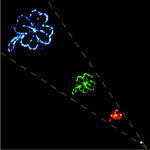 The long-term vision of revolutionary bottom-up nanotechnology is based on two different concepts of molecular assembly technologies. One follows Nature's blueprint, which uses molecular recognition for self-assembly of nanoscale materials and structures; the other is man-made and uses instruments to assemble nanoscale building blocs into larger structures and devices. In contrast, the most common nanoscale fabrication techniques used today, for instance in the sub 100-nanometer semiconductor industry, are top-down approaches where fabrication technologies such as lithography or stamping are used. Here, you create ever smaller structures by starting with a block of material and remove the bits and pieces you don't want until you get the shape and size you do want. While top-down techniques can be highly parallel (semiconductor industry) it is not feasible to control single molecules with them. Using a hybrid approach that combines the precision of an atomic force microscope with the selectivity of DNA interactions, researchers in Germany have successfully demonstrated a technique that fills the gap between top-down and bottom-up since it allows for the control of single molecules with the precision of atomic force microscopy and combines it with the selectivity of self-assembly.
The long-term vision of revolutionary bottom-up nanotechnology is based on two different concepts of molecular assembly technologies. One follows Nature's blueprint, which uses molecular recognition for self-assembly of nanoscale materials and structures; the other is man-made and uses instruments to assemble nanoscale building blocs into larger structures and devices. In contrast, the most common nanoscale fabrication techniques used today, for instance in the sub 100-nanometer semiconductor industry, are top-down approaches where fabrication technologies such as lithography or stamping are used. Here, you create ever smaller structures by starting with a block of material and remove the bits and pieces you don't want until you get the shape and size you do want. While top-down techniques can be highly parallel (semiconductor industry) it is not feasible to control single molecules with them. Using a hybrid approach that combines the precision of an atomic force microscope with the selectivity of DNA interactions, researchers in Germany have successfully demonstrated a technique that fills the gap between top-down and bottom-up since it allows for the control of single molecules with the precision of atomic force microscopy and combines it with the selectivity of self-assembly.
Oct 10th, 2008
 In contrast to the often depicted model of a perfect hexagonal lattice cylinder shape of carbon nanotubes, these nanomaterials often become twisted, bent or otherwise deformed during their growth, processing, or characterization. Researchers have found that some of these defects can be associated with a rearrangement of atoms and bonds which in turn will impact on the band structure and therefore affects the electronic properties of the tube. Previous experimental Atomic Force Microscopy and Transmission Electron Microscopy studies of carbon nanotubes have clearly identified their susceptibility to collapse and theoretical predictions of the impact that these deformations have on the electronic properties have been formulated. Experiments at the University of Surrey in the UK are the first to show atomically resolved radially collapsed double-walled carbon nanotubes, bringing also clear evidence of changes in the fundamental electronic behavior of these systems in response to the deformation.
In contrast to the often depicted model of a perfect hexagonal lattice cylinder shape of carbon nanotubes, these nanomaterials often become twisted, bent or otherwise deformed during their growth, processing, or characterization. Researchers have found that some of these defects can be associated with a rearrangement of atoms and bonds which in turn will impact on the band structure and therefore affects the electronic properties of the tube. Previous experimental Atomic Force Microscopy and Transmission Electron Microscopy studies of carbon nanotubes have clearly identified their susceptibility to collapse and theoretical predictions of the impact that these deformations have on the electronic properties have been formulated. Experiments at the University of Surrey in the UK are the first to show atomically resolved radially collapsed double-walled carbon nanotubes, bringing also clear evidence of changes in the fundamental electronic behavior of these systems in response to the deformation.
Oct 9th, 2008
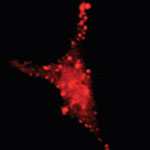 The study of individual live cells is a hugely important scientific task and essential to the field of molecular biology and biomedical research. Among the most significant technical challenges for performing successful live-cell imaging experiments is to maintain the cells in a healthy state and functioning normally on the microscope stage while being illuminated. Especially if scientists want to look into cellular processes that occur inside cells in their natural state and that cannot be observed by traditional cytological methods. Quantum dots (QDs), also called nanocrystals, hold increasing potential for in vitro and in vivo cellular imaging. For instance, we have previously reported about how researchers have used QDs for in vivo imaging of embryonic stem cells in mice, a novel technique that has opened up the possibility of using QDs for fast and accurate imaging applications in stem cell therapy. The usefulness of quantum dots comes from their peak emission frequency's extreme sensitivity to both the dot's size and composition. QDs have been touted as possible replacements for organic dyes in the imaging of biological systems, due to their excellent fluorescent properties, good chemical stability, broad excitation ranges and high photobleaching thresholds.
The study of individual live cells is a hugely important scientific task and essential to the field of molecular biology and biomedical research. Among the most significant technical challenges for performing successful live-cell imaging experiments is to maintain the cells in a healthy state and functioning normally on the microscope stage while being illuminated. Especially if scientists want to look into cellular processes that occur inside cells in their natural state and that cannot be observed by traditional cytological methods. Quantum dots (QDs), also called nanocrystals, hold increasing potential for in vitro and in vivo cellular imaging. For instance, we have previously reported about how researchers have used QDs for in vivo imaging of embryonic stem cells in mice, a novel technique that has opened up the possibility of using QDs for fast and accurate imaging applications in stem cell therapy. The usefulness of quantum dots comes from their peak emission frequency's extreme sensitivity to both the dot's size and composition. QDs have been touted as possible replacements for organic dyes in the imaging of biological systems, due to their excellent fluorescent properties, good chemical stability, broad excitation ranges and high photobleaching thresholds.
Oct 8th, 2008
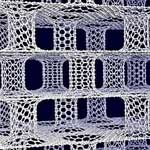 Safe, efficient and compact hydrogen storage is a major challenge in order to realize hydrogen powered transport. According to the U.S. Department of Energy Freedom CAR program roadmap, the on-board hydrogen storage system should provide 6 weight % of hydrogen capacity at room temperature to be considered for technological implementation. We have written several Nanowerk Spotlights where we introdduced and described novel, nanotechnology-based concepts for economically viable hydrogen storage methods. Scientists consider the storage of hydrogen in the absorbed form as the most appropriate way to solve the storage problem and one particular group of materials they have focused on are carbon nanomaterials like nanotubes or fullerenes. Offering a novel material approach, a theoretical investigation by researchers in Greece has shown that CNTs and graphene sheets could be combined to form novel 3-D nanostructures capable of enhancing hydrogen storage.
Safe, efficient and compact hydrogen storage is a major challenge in order to realize hydrogen powered transport. According to the U.S. Department of Energy Freedom CAR program roadmap, the on-board hydrogen storage system should provide 6 weight % of hydrogen capacity at room temperature to be considered for technological implementation. We have written several Nanowerk Spotlights where we introdduced and described novel, nanotechnology-based concepts for economically viable hydrogen storage methods. Scientists consider the storage of hydrogen in the absorbed form as the most appropriate way to solve the storage problem and one particular group of materials they have focused on are carbon nanomaterials like nanotubes or fullerenes. Offering a novel material approach, a theoretical investigation by researchers in Greece has shown that CNTs and graphene sheets could be combined to form novel 3-D nanostructures capable of enhancing hydrogen storage.
Oct 7th, 2008
 Back in the early 1800's it was observed that certain chemicals can speed up a chemical reaction - a process that became known as catalysis and that has become the foundation of the modern chemical industry. By some estimates 90% of all commercially produced chemical products involve catalysts at some stage in the process of their manufacture. Catalysis is the acceleration of a chemical reaction by means of a substance, called a catalyst, which is itself not consumed by the overall reaction. The most effective catalysts are usually transition metals or transition metal complexes. New nanotechnology research with carbon nanotubes coming out of Germany contains some implications for catalysis in general. Researchers at the Fritz Haber Institute of the Max Planck Society in Berlin have been working for some time at metal-free catalysis using nanocarbons. While their focus initially has been on ethylbenzene, an aromatic hydrocarbon that plays an important role as an intermediate in the production of various plastic materials, they now have, for the first time, used carbon nanotubes to activate butane.
Back in the early 1800's it was observed that certain chemicals can speed up a chemical reaction - a process that became known as catalysis and that has become the foundation of the modern chemical industry. By some estimates 90% of all commercially produced chemical products involve catalysts at some stage in the process of their manufacture. Catalysis is the acceleration of a chemical reaction by means of a substance, called a catalyst, which is itself not consumed by the overall reaction. The most effective catalysts are usually transition metals or transition metal complexes. New nanotechnology research with carbon nanotubes coming out of Germany contains some implications for catalysis in general. Researchers at the Fritz Haber Institute of the Max Planck Society in Berlin have been working for some time at metal-free catalysis using nanocarbons. While their focus initially has been on ethylbenzene, an aromatic hydrocarbon that plays an important role as an intermediate in the production of various plastic materials, they now have, for the first time, used carbon nanotubes to activate butane.
Oct 6th, 2008
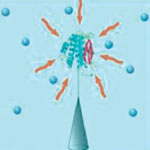 Genomics and proteomics, the studies of genes and proteins, provide the underlying basis for many advances in drug development and effective treatments of diseases. These studies heavily rely on unveiling the behavior of a single DNA or protein in an investigative sample. You could compare this challenge to somehow finding, then catching and monitoring a particular fish in a vast ocean. The scientific term for 'catching the fish' is 'immobilization' - a powerful technique for the study of biochemical systems that allows for the continuous observation of dynamic behavior of a chosen target. Immobilization methods anchor the to be observed molecule onto a surface in order to restrict it from escaping the observation volume. Researchers have now developed a new platform which consists of a carbon nanotube nanoneedle for capturing, isolating and measuring the activity of miniscule amounts of proteins.
Genomics and proteomics, the studies of genes and proteins, provide the underlying basis for many advances in drug development and effective treatments of diseases. These studies heavily rely on unveiling the behavior of a single DNA or protein in an investigative sample. You could compare this challenge to somehow finding, then catching and monitoring a particular fish in a vast ocean. The scientific term for 'catching the fish' is 'immobilization' - a powerful technique for the study of biochemical systems that allows for the continuous observation of dynamic behavior of a chosen target. Immobilization methods anchor the to be observed molecule onto a surface in order to restrict it from escaping the observation volume. Researchers have now developed a new platform which consists of a carbon nanotube nanoneedle for capturing, isolating and measuring the activity of miniscule amounts of proteins.
Oct 3rd, 2008
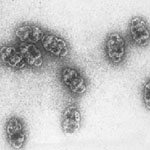 Spheres can be found at all scales in both the inanimate and living world for the basic physical property of encapsulation. There has been a fair amount of work by nanotechnology researchers on putting non-biological molecules or clusters into viruses or virus-like artificial nanocontainers. Although viruses are a type of protein cage, they are not a natural part of the cell. There is a class of biological protein nanocapsules though - called vaults - that is part of cells - although their cellular functions and gating mechanism are not yet understood. Vault nanoparticles are already present in human cells in high numbers (approx. 10,000 per cell) and their hollow barrel-like structure with a large internal volume seems well suited for encapsulation purposes.
Spheres can be found at all scales in both the inanimate and living world for the basic physical property of encapsulation. There has been a fair amount of work by nanotechnology researchers on putting non-biological molecules or clusters into viruses or virus-like artificial nanocontainers. Although viruses are a type of protein cage, they are not a natural part of the cell. There is a class of biological protein nanocapsules though - called vaults - that is part of cells - although their cellular functions and gating mechanism are not yet understood. Vault nanoparticles are already present in human cells in high numbers (approx. 10,000 per cell) and their hollow barrel-like structure with a large internal volume seems well suited for encapsulation purposes.
Oct 2nd, 2008
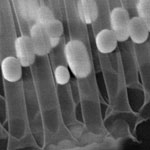 Our Spotlight today again shows an example of the very fundamental research that is taking place in labs around the world to lay the foundation for future nanotechnology based devices. It illustrates the very early stage of development and the nature of the fundamental challenges that make up today's 'nanotechnology research. The vision of revolutionary bottom-up nanotechnology is based on a concept of molecular assembly technologies where nanoscale materials and structures self-assemble to microscale structures and finally to macroscopic devices and products. Researchers are a long, long way from realizing this vision but they are busily laying the foundation for nanoscale engineering. Assembling nanoscopic components into macroscopic materials is an appealing goal but one of the enormous difficulties lies in bridging approximately six orders of magnitude that separate the nanoscale from the macroscopic world. Right now, nanotechnology researchers have their hands full just learning how to control a straight chain of nanoparticles.
Our Spotlight today again shows an example of the very fundamental research that is taking place in labs around the world to lay the foundation for future nanotechnology based devices. It illustrates the very early stage of development and the nature of the fundamental challenges that make up today's 'nanotechnology research. The vision of revolutionary bottom-up nanotechnology is based on a concept of molecular assembly technologies where nanoscale materials and structures self-assemble to microscale structures and finally to macroscopic devices and products. Researchers are a long, long way from realizing this vision but they are busily laying the foundation for nanoscale engineering. Assembling nanoscopic components into macroscopic materials is an appealing goal but one of the enormous difficulties lies in bridging approximately six orders of magnitude that separate the nanoscale from the macroscopic world. Right now, nanotechnology researchers have their hands full just learning how to control a straight chain of nanoparticles.
Oct 1st, 2008
 The long-term vision of revolutionary bottom-up nanotechnology is based on two different concepts of molecular assembly technologies. One follows Nature's blueprint, which uses molecular recognition for self-assembly of nanoscale materials and structures; the other is man-made and uses instruments to assemble nanoscale building blocs into larger structures and devices. In contrast, the most common nanoscale fabrication techniques used today, for instance in the sub 100-nanometer semiconductor industry, are top-down approaches where fabrication technologies such as lithography or stamping are used. Here, you create ever smaller structures by starting with a block of material and remove the bits and pieces you don't want until you get the shape and size you do want. While top-down techniques can be highly parallel (semiconductor industry) it is not feasible to control single molecules with them. Using a hybrid approach that combines the precision of an atomic force microscope with the selectivity of DNA interactions, researchers in Germany have successfully demonstrated a technique that fills the gap between top-down and bottom-up since it allows for the control of single molecules with the precision of atomic force microscopy and combines it with the selectivity of self-assembly.
The long-term vision of revolutionary bottom-up nanotechnology is based on two different concepts of molecular assembly technologies. One follows Nature's blueprint, which uses molecular recognition for self-assembly of nanoscale materials and structures; the other is man-made and uses instruments to assemble nanoscale building blocs into larger structures and devices. In contrast, the most common nanoscale fabrication techniques used today, for instance in the sub 100-nanometer semiconductor industry, are top-down approaches where fabrication technologies such as lithography or stamping are used. Here, you create ever smaller structures by starting with a block of material and remove the bits and pieces you don't want until you get the shape and size you do want. While top-down techniques can be highly parallel (semiconductor industry) it is not feasible to control single molecules with them. Using a hybrid approach that combines the precision of an atomic force microscope with the selectivity of DNA interactions, researchers in Germany have successfully demonstrated a technique that fills the gap between top-down and bottom-up since it allows for the control of single molecules with the precision of atomic force microscopy and combines it with the selectivity of self-assembly.
 Subscribe to our Nanotechnology Spotlight feed
Subscribe to our Nanotechnology Spotlight feed





